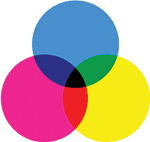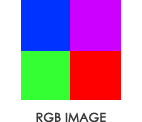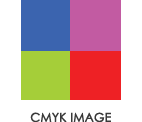CMYK Printing
Can you explain the difference between RGB mode & CMYK mode?
No problem! Firstly, don't be put off by the information displayed below, this is the same situation whichever printer you use, the only difference is that we lay out the facts to keep you informed.
When supplying files for full colour printing, it is important that you supply your artwork in the correct colour mode/space. Many software programs give you the choice to work in either RGB mode or CMYK mode, CMYK mode is the correct colour space for full colour printing.
RGB - An Explanation:
RGB stands for Red, Green and Blue which are the primary colours of light. Scanners and digital cameras generally create images using combinations of the three RGB colours. When you save a scanned image or photo taken with your digital camera, it will normally be saved in RGB mode unless otherwise specified. Artwork, images and photographs created in RGB mode are fine for use on websites, however, they cannot be used for printing on commercial print presses.
CMYK - An Explanation:
Printing presses print full colour images using a different set of colours to RGB. Generally, full colour images are created using the primary colours of pigment: Cyan (blue), Magenta (red), Yellow and Black, otherwise known as 'CMYK printing' or '4 colour process', black is designated the letter 'K' to avoid confusion with 'B' for blue. Because the inks used are translucent they can be overprinted and combined in a variety of different proportions to produce a wide range of colours, an example is shown in the diagram below. In theory an overprint of all 3 process colours Cyan, Magenta and Yellow produces the appearance of black, however, in reality this is a muddy brown, for this reason black is used as the fourth printing ink.

Can you show some examples and explain further?
If you have not designed your artwork from scratch then at some stage in the design process, your artwork or images used must be converted from RGB mode to CMYK mode in order to print. Unfortunately not all colours in the RGB spectrum can be replicated, such colours are said to be 'out of the CMYK colour gamut'. When converting from RGB mode, software programs get as close to the original colours as possible, some colours convert very well and others don't. Below is an example of some bright RGB colours that do not convert well. As you can see the image looks slightly muted and not as vibrant as its RGB counterpart.


In the majority of cases this slight variation is only apparent if you have created your artwork from scratch in RGB mode using very bright/vivid individual colours. For example, you have chosen a very bright/vivid red or yellow for the lettering in your logo which looks fantastic on your monitor, when this is converted to CMYK mode this red or yellow will be toned down and not as bright/vivid, this may look a little dull compared to what you originally designed, however, we can only print what is possible. Graphic designers will always use a CMYK colour space as they know that these almost illuminous RGB colours are just not printable, hence, if you have had your artwork designed by a professional graphic designer then you should not have to worry about any of this.
Do not be alarmed by the example above, most photographic images actually convert very well with little or no difference. Below is an example of a converted photograph where you can hardly see a change in colour.


If you are providing print ready artwork then you must ensure that you convert your artwork (if needed) to CMYK mode prior to sending your files to us. By doing this yourself you will have more control over the appearance of your printed piece as you will see how the images look once they are converted. If need be you can always adjust your artwork slightly after conversion to ensure it looks how you want it to. Remember you are viewing your CMYK artwork on an RGB monitor so this will not be a 100% accurate representation, however, this will give you a rough idea as to what the printed colours will look like. If we receive print ready artwork from you in RGB mode, we will do a standard conversion, however, our results may vary from what you expect and this is at your risk, hence we advise that you supply all artwork already converted.
For the best results we recommend working in CMYK mode from the beginning of the design process, converting any photographs or scanned images prior to pasting them into your artwork. Some graphic design software like Adobe Photoshop and Adobe Illustrator allow you to work in different colour modes so ensure you have chosen CMYK mode from the start.
